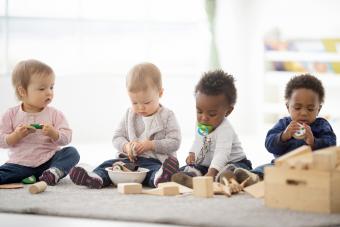
Parents who place their children in daycare put great trust into the supervision and daily instruction of their children. Be sure to select a daycare that offers quality care and also top-notch curriculum programming. Because your kid spends so much of their day here, you'll want to ensure that they receive the best experience to help them grow and develop.
Researching Daycare Facilities
No two daycare centers are the same. Each has its own structure, programming, and environment. Be sure to look into several childcare options before landing on one that best suits your family's needs. When researching daycare facilities, pay particularly close attention to:
- Location - Choose a daycare center that is close to your home or your work to reduce morning and evening commute times
- Staff/child ratio - This varies depending on the state you live in
- Daily schedule - Does it complement your child's current daily schedule? Does it include rest time, snack time, creative play, and time spent outdoors?
- Curriculum for the child's age - Does the center's curriculum match the developmental skills expected for children depending on their age?
- Curriculums for the next few years - Does the center's curriculum grow with your child? Will it prepare them for entering elementary school?
- Childcare Costs - Does the cost of childcare fit your budget?
Importance of Daycare Curriculums
The structure of the day is fundamental to the welfare of children. If you are a daycare provider, you should put a lot of emphasis on the curriculum you are using to teach the children in your care. Well thought out curricular plans help parents keep track of what their kids are doing each day, while aiding children in developing both socially, emotionally, and academically, so they can readily enter primary school in the coming years.
Cute and Creative Daycare Theme Ideas
A sign of a well-thought-out daycare curriculum includes activities that surround a weekly or monthly theme. Having a theme creates consistency for the children and can make it easier to plan. Some centers have monthly curriculums, where the major activities all center around a broad theme, while others have a weekly theme that changes every Monday. When it comes to curricular themes, the sky is truly the limit. Choose a theme that gives you plenty of space to expand and explore. If choosing a monthly theme, the broader, the better. Pick themes that center around seasons, interests of children, or developmental skills and milestones.

- On the farm - Explore farm animals, jobs of the farmer, and where food comes from.
- Community jobs/careers - An excellent theme for older children who have a sense of occupations performed in the outside world.
- Letter of the week - Do crafts that begin with the letter of the week, work on writing the letter, read books that begin with the letter of the week, play a game that begins with the letter of the week (Musical chairs for letter "M," or Freeze Tag for "F").
- Family and pets - Read stories about different animals, older children can research the cost and care of their dream pet, have a Bring Your Stuffed Pet Animal to School day.
- Animals - Dive into the animals all over the world. Learn about interesting creatures and their natural habitats.
- Weather - Weather is an excellent theme to utilize with science. Teach calendar skills, graphing, do crafts based on different weather elements, and have a class weatherman every day.
- Shapes or colors - Essential skill for young children. Great for a monthly theme where each week can be broken down into a specific color and/or shape.
- Holidays - This can center around common holidays and traditions in your part of the world, or choose to learn about a different culture's holidays every week.
- In the kitchen - Work in cooking, creating, and eating. Learn how to make basic snacks. Older children can hone in on measuring skills and recipe writing and reading. Create a cookbook of all the recipes the class creates while learning about this theme.
- Famous authors - For younger children, choose authors such as Eric Carle or Sandra Boyton. Read their stories, re-create their iconic art, and do crafts that correlate to some of the popular work these authors have produced.
- Things that move - Become familiar with basic movement skills of objects and of bodies. Pair movement with vocabulary that will enhance children's understanding of the skill.
- Fairy tales and nursery rhymes - Another good theme for centers focusing on a monthy theme. Have a different story or rhyme each week. Create a classroom nursery rhyme. Crafts and art can center around the fairy tale or rhyme of the week.
- Dinosaurs - Take a virtual field trip to famous museums, read books about dinosaurs, and turn your classroom into a prehistoric palace!
- Under the Sea - Kids love learning about the mysterious world of the ocean. Discover the plants and animals that call the sea home. Have a beach dress-up day in class and watch nature programs that center around the sea.
Putting the Theme Together
Once you have decided on a theme for each month or week, you need to make sure your activities, snacks, and crafts all tie it together. You can find curriculums already available which will give you ideas, or you can create your own. Each curriculum should fit into different learning styles and learning skills, and while you can tailor them to your center's unique needs, most themes should include common ideas and activities.
Crafts
Crafts encourage creativity and fine motor skills and should be a daily part of your daycare curriculum. Adapt each craft for varying age and development groups. While crafts should be something kids do each day, not all crafts must be intricate and complicated.

Examples of craft ideas include:
- Cutting
- Pasting or taping
- Making edible playdough
- Cooking or decorating cookies
- Fingerpainting
- Coloring
Activities
Your daily activities should also fit into your theme. If you do circle time, this is a great opportunity to introduce the theme with a story. Other activities you can include are:
- Sing a song, dance, and play instruments
- Play a game related to the theme
- Share visuals (for example, if you are doing careers, introduce a firefighter and doctor. Bring a feather, egg, and nest if your theme is birds).
- Have a discussion
- Show and tell
- Academic extension activities - handwriting, graphing, journaling
Pretend Play Is More Than Just Play
Children benefit from the opportunity to dress up and role play. Find dress-up clothes and costumes that fit into your theme by checking out local thrift shops. Create a fun backdrop, or build a playhouse that ties into your theme. Create a mock fire station, a post office, and a school for a theme centered around community jobs. Turn your classroom into a zoo where kids infuse themselves into the theme wholly and completely.
Here is a list of items to keep on hand:
- Play clothes and uniforms
- Pretend jewelry and accessories like shoes, briefcases, and purses
- A playhouse, kitchen, mailboxes, brooms, bins, and other items that can easily be worked into numerous themes.
- Large boxes and large roll construction paper that you can turn into anything your imagination desires.
- A puppet theatre and puppets
Many household items can be turned into anything a child dreams up. Keep items stored at your facility in a space where they can easily be accessed for different themes year after year.
Physical Movement
Part of your curriculum needs to involve getting up and moving. You can play games that fit your theme, like London Bridge, or make a train for a 'things that move' theme. Play Duck-Duck Goose if you are doing an animal theme, or a safe version of the classic game Red Rover. Allow the children some free time to use some of their extra energy. Head outdoors when the weather permits or utilize a bonus room or gymnasium to take physical movement outside the general classroom.

Even when working within the small confines of a classroom, you will want kids physically engaged whenever possible. They don't have to be running around the room, and shouldn't be, but they can play Simon Says, social games like charades, and seat yoga.
Education
Your curriculum needs to teach developmental skills while being engaging and fun. The overall academic focus will depend on the ages and milestones of each child. Be sure your theme addresses the needs of children specific to their personal development and growth.
Teaching Babies
Babies basically need to be held, fed, changed, nurtured, and loved. However, incorporating a curriculum with songs, nursery rhymes, and interaction will make a difference in their learning. Spend time on the floor with your babies, helping them grow. Create an environment that is visually stimulating for little ones and work in music tailored to infants' sensory capacity.
Teaching Toddlers
Toddlers learn a lot through play. You will want to incorporate simple beginning concepts into the instruction for this group of children to prepare them for preschool. Make sure you are doing:

- Songs
- Nursery rhymes
- Basic colors
- Shapes and sorting
- Counting
- Fine motor skills like putting a thread through a hole and stacking blocks
- Gross motor skills include jumping, skipping, acting out certain movements, clapping, stomping, and crawling.
- Social activities such as sharing, partner play, small group, and large group activities
Teaching Preschoolers
When your children hit preschool age, three to five, they are ready to begin:
- Tracing and sometimes writing (including their name)
- Recognizing some alphabet letters and their beginning sounds
- Identifying colors and basic shapes
- More complex crafts and cutting along lines and gluing
- Opposites
- Matching
- Coloring
Communicating Your Curriculum
You will spend a lot of time researching and creating weekly and monthly curriculums, so be sure to share all that you do with your children's families. Consider sending home a weekly or monthly newsletter to parents, keeping them up to date on the activities you are working on, and their child's progress. Hang creative arts and crafts done by kids all over your building. Communication with parents can make a big difference in satisfied customers. It assures them that you have their children's needs and interests at heart, which is the absolute number one priority of any quality daycare center and staff.







